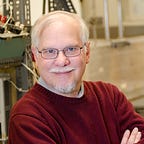Scientific conferences in the era of Covid-19 — further thoughts
As most of us shelter in place, many voices have suggested that this is an excellent to time to reflect on and perhaps reform some basic aspects of society, such as the pay of “essential workers” or universal health care. The scientific enterprise is no exception; in particular, the pandemic has hastened an already ongoing movement to rethink a cornerstone of the enterprise, the scientific conference. As I wrote last time, the recent International Association for Landscape Ecology — North America chapter meeting I attended was transformed in an astonishing five weeks from a traditional in-person meeting to fully online. But the movement in this direction had already started; Janet Silbernagel, then President of IALENA wrote to membership in April: “ In becoming IALE-North America last year, we had an immediate goal to encourage more participation from Mexico and other parts of North America, while also recognizing that meetings outside of the US might pose travel barriers for US government employees. So, we were planning to pilot some virtual conference options at Toronto that could become models for future meetings. Well, the ‘pilot’ soon became a full-on venture for this year.”
This e-mail touched on one of the real difficulties of the traditional conference format: they are often difficult and/or expensive to get to and that some participants may be blocked from attending for non-scientific reasons. Many potential attendees may be concerned with the carbon footprint associated with air travel. Conferences also have the not-inconsiderable expenses associated with registration, housing, and meals. There are also add-on charges associated with activities such as workshops and field trips. A few years ago, I helped organize an IALE meeting in Chicago (it was then the U. S. chapter). As much as we tried to keep costs down, it was still prohibitively expensive for many attendees and almost certainly precluded many from attending. Total costs for a professional attending a large professional meeting, such as the Geological Society of America, can come to thousands of dollars. For those without institutional or grant support, money for going to a meeting comes from, as my colleague Tony Martin puts, MYOP (my own pocket). Clearly there is a class bias based on finances.
But there are also other, often unconscious, class biases about conferences, which I share. I was prompted to think of them by two correspondents responding to my initial essay (at their request, I am anonymizing their comments). These involve mainly the social aspects of the meeting, which I wrote of so enthusiastically. I have come from a place of privilege in this regard: I attended prestigious institutions, my advisors were major figures in the field, and I had a large coterie of fellow graduate students. There was also a great deal of cross-pollination with similar institutions. The inevitable result is the formation of a community that is somewhat clannish and appears insular. This creates real issues for those outside the community; as one correspondent wrote, “When I go to GSA, AGU, SVP, etc., everyone meeting up with their old friends and colleagues, and their promising students, tend to form cliques that exclude people, say, who have come from abroad and don’t have their supervisor there to introduce them as a promising student, who don’t have their cadre of lab members for support, who didn’t go to grad school with ‘the guys’, who don’t have the finances to go to that new interesting restaurant in a new town for dinner. I have found most in-person meetings alienating, exhausting and lonely.” My other correspondent echoed this indicating that “Conferences for me were always stressful, intensely isolating experiences, and while the content of particular talks was often interesting, the crush and noise of so many people ended up being overwhelming. As an undergraduate, I was told that conferences were essential to “networking,” but I never understood exactly how to do that, and it became one more thing I was told about but never actually taught. I never knew what to say or who to say it to, and I never felt any sense of welcome or belonging… For me that absence of community, that excruciating loneliness in a noisy throng, is what science feels like.”
As a community, we need to recognize the authenticity of such experiences and find creative methods for making everyone feel welcome. This extends also to others who might have barriers to participation, including those with disabilities* or from disadvantaged areas or countries. The virtual meeting, as it evolves, is certainly a mechanism to address this. As one of my correspondents says “I hope the advent of virtual meetings continues so I can hear from students and researchers in Africa, South America, Asia, Australia even, as loud and clear as North American and Europe, without shame around not being able to pay to go out for dinners.” And I will encourage everyone to reach out to that student or colleague at a meeting who seems lost or alone. Let no one be alone in the noisy throng!
* A marvelous organization that addresses issues of accessibility in the geosciences is the International Association for Geoscience Diversity https://theiagd.org/.
